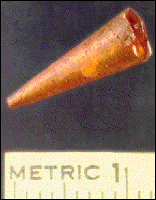R. Winn Hardin
TROY, N.Y. -- Researchers at Rensselaer Polytechnic Institute have revived a bit of history in time for the first commercial blue-diode lasers.
Companies hoping to manufacture blue lasers face several significant obstacles, including structural and chemical mismatches between sapphire substrates and gallium nitride active layers. A better solution would be to have a substrate with a similar crystalline structure, said Leo Schowalter, chairman of the institute's physics department .
Glen Slack has had the answer for 20 years. Now a research professor at the institute, he first developed a method to grow bulk aluminum nitride while working at General Electric, but "no one was interested [in nitrides] back then," he said.

To make substrates, the bulk aluminum nitride crystal cone would be cut into 0.5-mm slices.
|
The technique, called sublimation-recondensation, starts by evaporating polycrystalline aluminum nitride and then condensing the vapor (which consists primarily of aluminum atoms and nitrogen molecules) in a specially designed tungsten crucible at 2300 °C. Initially, the aluminum vapor degraded the crucible, limiting its lifetime, but subsequent design improvements solved the problem. The result is an aluminum nitride crystal boule 1.2 cm long and 1 cm wide that offers a minimal (2.2 percent) crystal mismatch with gallium nitride.
Researchers in Poland have had some success at growing gallium nitride platelets -- the best possible solution but the process must be done at 2000 atmospheres and takes three days to produce five to 10 10-mm platelets.
The aluminum nitride process can grow crystals at a rate of 0.3 cm per hour. The group hopes to improve on that rate while expanding the crystal diameter to 5 cm within the next two years.
More than a mechanical base
Aluminum nitride also offers better thermal conductivity than sapphire, meaning that it functions better as a heat sink for diode lasers.
The material also has strong piezoelectric properties that hold promise for the personal communications service industry. Because the acoustic velocity is 10 times that of lithium niobate, aluminum nitride could make possible generations of mobile phones that operate at higher frequencies than today's models.